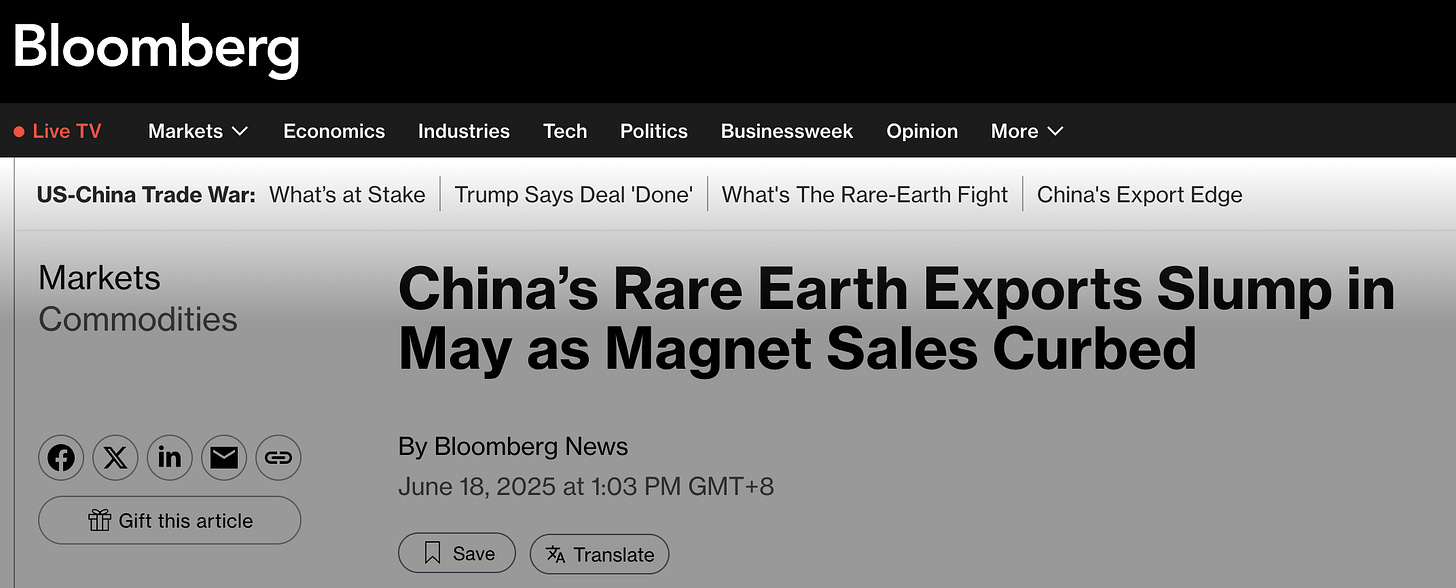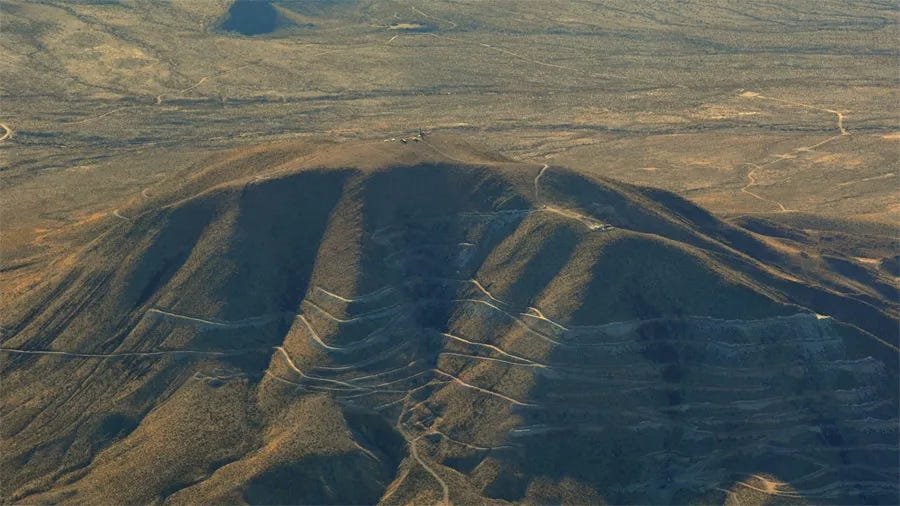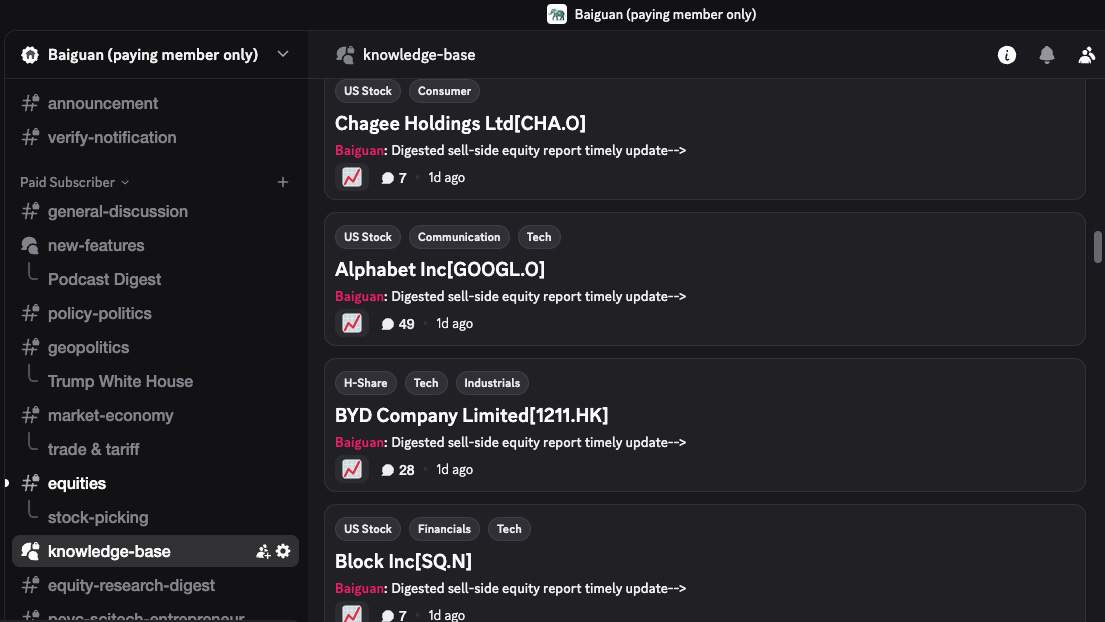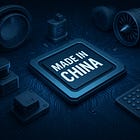Rare earth resources aren’t unique to China—yet somehow, they’ve become one of Beijing’s most potent bargaining chips in trade negotiations.
While the US scrambles to “de-risk” from Chinese supply chains, here’s the irony: in the face of rare-earth magnet shortages, several major automakers have reportedly considered moving some parts production to China [wsj]. In other words, Trump’s trade war may have accidentally helped bring manufacturing back—to the other side.

So what exactly is China’s stranglehold on rare earths? Is it about raw resources, refining capacity, or something more structural? And how critical is China’s dominance—really—to the U.S. and its allies? More importantly, how long can this strategic leverage last?
To help unpack these questions, we’re translating a comprehensive deep dive from South Reviews (南风窗), a biweekly politics and economics magazine in China. Below is Baiguan's translation of the original article "The strategic power of rare earths".
(Please note: this article was originally written on June 6. Some of the events mentioned have since seen further developments.)
The strategic power of rare earths
On June 6, just a day after a phone call between the Chinese and U.S. presidents, Donald Trump declared publicly, “Yes, he agreed.” He claimed that China had agreed to resume exports of rare earth minerals and magnets to the United States.
Three days later, trade officials from both countries met in London, with talks centered on rare earths, technology, and tariffs.
If the U.S. holds the upper hand in semiconductors, China has leverage over rare earths. These two strategic assets have become the defining weapons in the ongoing trade standoff. After Washington imposed sweeping export restrictions on high-performance chips to China, Beijing responded by tightening its grip on rare earth exports.
In stark contrast to Washington’s frequent and unilateral wielding of export controls, Beijing has exercised extreme caution when it comes to administrative measures that could disrupt global supply chains. The rare earth restrictions were not a matter of tactical retaliation, but a signal that China’s tolerance had reached its limit.
If one must draw comparisons, China’s rare earth curbs bear more resemblance to Cold War-era mechanisms like the Coordinating Committee for Multilateral Export Controls (CoCom) or the Wassenaar Arrangement — both frameworks long used by the West to restrict strategic materials. Notably, despite years of technology blockades, China had refrained from using rare earths as a geopolitical counterweight — until now. What changed? Many in China see the Trump administration’s actions — unilateral, sweeping, and often untethered from international norms — as the tipping point. In their view, this wasn’t a tit-for-tat, but a recalibration of patience.
Rare earths are deeply embedded in the high-tech manufacturing ecosystem. The auto industry feels the most immediate impact, but the ripple effects extend to semiconductors, medical imaging chemicals, robotics, offshore wind turbines, and advanced weaponry. Just a week ago, Ford temporarily shut down its Chicago plant due to rare earth shortages. Meanwhile, the European Association of Automotive Suppliers, headquartered in Brussels, issued a stark warning of potential shutdowns across the sector.
Though tariff disputes between the U.S. and China remain unresolved, it is rare earth exports that now strike at the heart of global supply chains. For the U.S., hopes of finding a rare earth “Plan B” may remain wishful thinking — at least in the near term.
China’s rare earth dominance
On April 2, the Trump administration announced sweeping new tariffs on Chinese imports. Just two days later, Beijing struck back — imposing export restrictions on seven categories of medium and heavy rare earth elements, including samarium, gadolinium, terbium, dysprosium, lutetium, scandium, and yttrium. The move sent shockwaves through global markets.
Rare earths comprise a group of 17 elements, typically categorized into light, medium, and heavy groups. These materials are indispensable for making high-performance magnets used in both civilian and military technologies. Among them, medium and heavy rare earths — critical for aerospace, defense, and other cutting-edge sectors — are particularly scarce and difficult to source.
Don’t be fooled by their size. Rare earth magnets are no larger than a stick of chewing gum, yet pack magnetic force 15 times stronger than traditional iron magnets. Heat-resistant and cost-efficient, they are essential components in electric motors — not only in EVs and hybrid vehicles, but also in robots, drones, offshore wind turbines, missiles, and fighter jets.
China holds an overwhelming lead in both rare earth mining and processing.
According to the International Energy Agency, China accounted for over 60% of global rare earth mining output in 2023 — and an even more dominant 92% of the world’s refining capacity. According to the International Energy Agency, China accounted for over 60% of global rare earth mining output in 2023 — and controlled a staggering 92% of global refining capacity. In effect, most of the world’s rare earths must pass through China before they can be integrated into downstream industries. Between 2020 and 2023, 70% of the rare earth compounds and metals used in the U.S. were imported from China, according to the U.S. Geological Survey.
As supply tightened, international prices of rare earth materials surged.
According to Argus Media, a leading global provider of commodity price benchmarks, the average landed price of dysprosium oxide in Europe rose 167.8% between early April and June 5. On that same day, the price gap between China’s offshore price and Europe’s import price exceeded $460 per kilogram. Terbium oxide followed a similar trend, with European prices nearly doubling in two months and a striking $1,500 per kilogram premium over China’s quote.
Under growing pressure from soaring costs, automakers are sounding the alarm.
Rare earth magnets, though small in size, are indispensable in modern vehicles. Exposed to high temperatures or strong electromagnetic fields, traditional magnets quickly lose their effectiveness. To counter this, manufacturers add trace amounts of heavy rare earths like dysprosium or terbium to ensure thermal stability.
Both gasoline and electric engines generate significant heat, requiring magnets that can withstand high operating temperatures. A single car contains dozens of small electric motors—for brakes, power steering, speakers, windshield wipers, headlights, and more. A luxury car seat alone may contain up to 12 rare earth magnets to power its multiple adjustment motors.
Ford recently halted production for a week at its Chicago plant due to rare earth shortages, affecting its Explorer SUV line. In early June, the Motor & Equipment Manufacturers Association (MEMA), along with General Motors, Toyota, Volkswagen, Hyundai, and other major automakers, issued a joint letter warning that without a stable supply of rare earth magnets, production of essential components could come to a standstill.
Several Indian carmakers are facing the same pressure. Suzuki, Tata Motors, and Mahindra have all reported dangerously low inventories of rare earth materials, urging Prime Minister Modi to negotiate with Beijing to restore export permissions.
Even Elon Musk’s humanoid robot, Optimus, relies heavily on rare earths. Each unit requires more than 3.5 kilograms of rare earth materials for its motors. Musk has reportedly submitted an application to Chinese regulators in hopes of securing an export license.
Rare earths are also critical to national defense.
Turbine blades in high-temperature jet engines require a protective thermal barrier made with yttrium, preventing the engines from melting mid-flight. According to the U.S. House Armed Services Committee, producing a single F-35 fighter jet requires roughly 0.4 metric tons of rare earths. A single Aegis-class destroyer uses about 2.4 tons, while a Virginia-class nuclear submarine consumes up to 4 tons.
Yet the U.S. defense industrial base holds only limited rare earth reserves. A 2024 analysis by the RAND Corporation warned that a 90-day disruption in rare earth supplies could force up to 78% of U.S. defense contractors to halt production.
China’s dominance is especially pronounced in refining — it supplies more than 90% of the world’s processed rare earths. Western dependence is acute: the only U.S. rare earth mine, Mountain Pass in California, produces light rare earths, but sends 80% of its output to China for processing. Japan, too, imports rare earth oxides from non-Chinese sources but still sends most of its magnet materials and components to China for final refining.
In recent years, geopolitical tensions have only deepened global reliance on China’s mineral supply chains.
In 2023, over 90% of U.S. rare earth imports came from China — a sharp increase from around 70% in 2013. Two key developments explain this surge. First, the war in Ukraine prompted U.S. sanctions against Russia, formerly the second-largest supplier of rare earths, effectively shrinking the pool of viable alternatives. Second, soaring demand for high-tech products — particularly robotics and electric vehicles — has intensified the global scramble for rare earths. At present, only China has the capacity to meet demand on such a scale.
Undermining" U.S. manufacturing from within
China’s dominance in the rare earth supply chain is no accident — it is the result of decades of deliberate policy and strategic investment.
In 1992, during a visit to Inner Mongolia, Chinese leader Deng Xiaoping famously declared: “The Middle East has oil; China has rare earths.” That remark would prove prescient.
In 2010, amid a territorial dispute with Japan, China imposed a two-month export ban on rare earths. Between 2009 and 2013, intermittent export controls pushed many global manufacturers to relocate operations to China, where access to rare earths was more secure.
Before 2010, rampant smuggling plagued the industry. Organized criminal groups were reportedly moving rare earth volumes equivalent to half of China’s annual output. One common method involved embedding rare earths into steel rebar for export, then re-melting it abroad to extract the materials. In this opaque supply chain, even major clients like Boeing, Volkswagen, and Toyota often sourced rare earths with unclear provenance.
Over time, Beijing tightened regulations. Many small steel and smelting plants were shuttered and replaced by fewer, larger, and more tightly supervised facilities.
Since Donald Trump’s first term, China has been preparing for the possibility of sanctions and investing heavily in contingency strategies to mitigate U.S. pressure. The rare earth export ban announced in April 2025 came as a direct response to the White House’s sweeping tariffs. In early May, senior officials from 11 ministries and seven provinces convened, and the Ministry of Commerce issued a joint statement emphasizing that “strategic mineral export controls are fundamental to safeguarding national security and development interests.” It also called for full-chain tracking of rare earth production and transportation.
The move won widespread public support in China, where many viewed it as a firm response to Trump’s latest tariff escalation. Just as the U.S. has enforced end-to-end controls on chip exports, Chinese commentators offered “strategic advice” on rare earth retaliation — suggesting that “every element should be regulated individually.”

Trump may now be beginning to grasp what a fantasy it is to bring manufacturing back to America — at least without access to China’s rare earth supply.
Following China’s export restrictions, multiple automakers and EV suppliers are reportedly considering relocating portions of their motor production to China to avoid supply chain disruptions. Some are exploring two-pronged strategies: either building electric motors entirely in China or shipping U.S.-made motors to China for magnet assembly.
“If you try to import magnets from China, they’ll be blocked,” one supply chain manager told reporters. “But if the magnets are already assembled inside a Chinese-made motor, customs won’t stop you.”
Are rare earth alternatives a myth?
After China’s 2010 export ban, Japan sought to build a two-year stockpile of rare earths.
With government financial backing, Sumitomo invested in Australian mining firm Lynas, securing up to 60% of Japan’s rare earth needs. Japan’s largest magnet manufacturers — Proterial (formerly Hitachi Metals), Shin-Etsu Chemical, and TDK — partially relocated production to China and shifted parts of their supply chain to lower-cost countries like Vietnam. Still, they maintained a sizable domestic output in Japan.
The U.S. once boasted the world’s largest rare earth magnet industry. Its Mountain Pass mine in California had supplied most of the global market since 1965. But in 1998, the mine was shut down following a pipeline leak that released trace heavy metals and radioactive materials into the Mojave Desert. Chinese firms made three separate attempts to acquire the mine — all blocked by U.S. authorities.
Alarmed by Japan’s supply crisis, the Obama administration supported Hitachi Metals’ investment in a rare earth magnet plant in North Carolina, operational from 2011 to 2013. But the costs were prohibitively high compared to China’s vertically integrated, state-backed operations in cities like Ganzhou. U.S. buyers, ultimately unwilling to pay a “made-in-America premium,” continued sourcing from Chinese suppliers. In 2020, Hitachi shut down the facility and mothballed its equipment.
Back in 2010, Mountain Pass — the U.S.’s only remaining rare earth mine — received over $1 billion in Pentagon funding just to stay afloat. But lacking commercial competitiveness, it shut down again the following year. In 2017, MP Materials acquired the site, restarted mining operations, and began exporting raw ore to China for processing. The company now plans to begin producing rare earth magnets at a new facility in Texas by the end of this year. Still, even at full capacity, its annual output would match just a single day of production in China.
The Trump administration cast a wide net in search of rare earth “substitutes.”
Desperate to secure alternatives, the Trump administration cast a wide net. Greenland, home to the world’s eighth-largest rare earth reserves, became an unexpected target. Trump even floated the idea of acquiring the island outright — hinting that economic or even military tools might be used to gain control.
Washington also turned to Ukraine, which holds about 5% of global rare earth deposits, along with major reserves of lithium and titanium. After sustained pressure from Washington, a bilateral mining agreement was signed, targeting Ukraine’s rare earth resources.
In addition, the U.S. is collaborating with Australia’s Lynas Corporation and the European Union’s Critical Raw Materials Resilience initiative on rare‑earth supply‑chain resilience to diversify global rare earth sources. Japan, meanwhile, is reportedly preparing to offer a bilateral deal centered on rare earth elements and liquefied natural gas (LNG) as part of its tariff negotiations with the United States — hoping to trade resources for tariff concessions.
Domestically, the Round Top project in Texas has emerged as a cornerstone of America’s rare earth strategy. Operated by U.S. Rare Earths Inc., the site holds estimated reserves of 130,000 metric tons across 16 different elements and aims to supply 20% of U.S. rare earth demand by 2027. The company is also building a $100 million magnet manufacturing facility in Oklahoma, which is expected to process up to 2,000 metric tons of rare earth materials annually.
Meanwhile, the U.S. Department of Energy has launched the ReElement initiative, allocating $50 million to recover up to 90% of rare earth elements from electric vehicle batteries by 2025. But these recycling systems have yet to achieve commercial scale and remain economically marginal.
The National Defense Authorization Act for fiscal year 2025 earmarks $1.2 billion for strategic stockpiling and $350 million for domestic development. These funds are being channeled into American firms like MP Materials, aimed at accelerating the construction of a domestic rare earth processing infrastructure.
While the U.S. is pursuing a dual-track approach — securing both overseas and domestic rare earth alternatives — the incentives offered still outweigh the realistic viability of these efforts.
Even if external regions like Greenland and Ukraine hold mineral reserves theoretically sufficient to meet U.S. demand, the true bottleneck lies not in mining — but in refining. Much of the world’s existing refining capacity is tailored to the specific technical standards of U.S. industries, allowing seamless integration into American supply chains. Rebuilding this infrastructure elsewhere would require a wholesale redesign of global supply routes — a process that cannot happen overnight.
Despite growing federal support, results have fallen short of expectations. According to the Center for Strategic and International Studies (CSIS), the Pentagon has invested over $439 million since 2020 to develop a rare earth industrial base — but most U.S. production remains in its early stages.
RAND Corporation estimates that it would take at least 10 years and $10–15 billion in investment to establish a fully independent domestic rare earth supply chain, factoring in infrastructure, permitting, environmental compliance, and workforce training.
In truth, the troubled half-century journey of Mountain Pass — America’s lone rare earth mine — encapsulates the blind spots of the “Made in America” ideal. Time and again, the U.S. sets out to rebuild domestic manufacturing, only to price itself out of competitiveness along the way.
*End of translation*
The bottom line
Following the recent US–China trade talks in London, Beijing pledged to establish a fast-track export approval process for rare earth shipments to the US, valid for six months. However, this agreement notably excludes high-performance magnets required by the US military, such as those used in fighter jets, submarines, and missile systems. [Reuters]
In practice, China has not banned the export of rare-earth permanent magnets outright, but only permits those used for civilian purposes. According to several sell-side research teams, even civilian-use exporters can apply for licenses, and approvals can take up to 45 working days. Some Chinese exporters have started shipping again under the new system, but with permit approvals taking weeks, overseas factories—especially those running on just-in-time inventory—are still at risk of running short.

What underpins China's leverage is not exclusive access to rare earths—they exist in many parts of the world—but Beijing's near-total control over the midstream: the refining and magnet production. Today, China’s rare earth industry is entirely state-controlled, led by China Rare Earth Group and Northern Rare Earth. This enables strict coordination over exports and pricing, giving Beijing a credible bargaining chip in broader trade negotiations.
The West has made slow progress in developing alternatives to Chinese rare earths. For now, China still holds a dominant position in both refining and permanent magnet production. In the short term, it remains extremely difficult for other countries to rebuild rare earth refining capacity and reduce reliance on China—not because of a lack of raw materials, but due to challenges around environmental approvals, technical barriers, and inefficient investment returns.
According to research by sell-side teams, even if rare earth production restarts in Australia or the US, it would still take at least 3 to 5 years—or even longer—to meaningfully replace China’s supply.
But as the article explains, rare earth resources aren’t exclusive to China, and its dominance in refining isn’t due to insurmountable technological barriers. So if global decoupling continues to deepen, China’s rare earth bargaining chip may not remain a guaranteed winning hand forever.
📣 Introducing Baiguan’s Private Discord for Paying Members
We are excited to announce the official launch of our paid-member-only Discord chat group! This exclusive community is designed to enhance your experience as a valued subscriber, providing a space for meaningful conversations, direct interactions, and a deeper connection with like-minded individuals.
Within our server, we dive deeper into topics and news headlines just like rare earths, and China-focused investment ideas. You’ll also gain access to equity research and market views from trusted institutional sources, all in a more interactive and timely format.
How to join:
First, become a paid member of Baiguan. Then simply click the link below and follow the instructions to gain access to the group.












